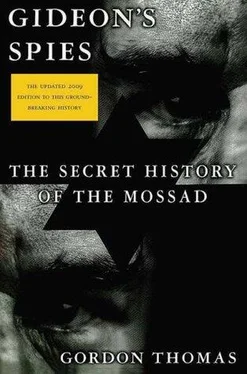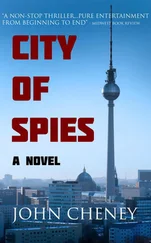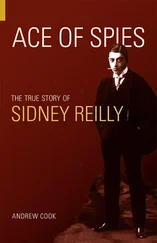Gordon Thomas - Gideon's Spies
Здесь есть возможность читать онлайн «Gordon Thomas - Gideon's Spies» весь текст электронной книги совершенно бесплатно (целиком полную версию без сокращений). В некоторых случаях можно слушать аудио, скачать через торрент в формате fb2 и присутствует краткое содержание. Город: New York, Год выпуска: 2009, ISBN: 2009, Издательство: Thomas Dunne Books, Жанр: История, на английском языке. Описание произведения, (предисловие) а так же отзывы посетителей доступны на портале библиотеки ЛибКат.
- Название:Gideon's Spies
- Автор:
- Издательство:Thomas Dunne Books
- Жанр:
- Год:2009
- Город:New York
- ISBN:978-0-312-53901-6
- Рейтинг книги:4 / 5. Голосов: 1
-
Избранное:Добавить в избранное
- Отзывы:
-
Ваша оценка:
- 80
- 1
- 2
- 3
- 4
- 5
Gideon's Spies: краткое содержание, описание и аннотация
Предлагаем к чтению аннотацию, описание, краткое содержание или предисловие (зависит от того, что написал сам автор книги «Gideon's Spies»). Если вы не нашли необходимую информацию о книге — напишите в комментариях, мы постараемся отыскать её.
Gideon’s Spies
Gideon's Spies — читать онлайн бесплатно полную книгу (весь текст) целиком
Ниже представлен текст книги, разбитый по страницам. Система сохранения места последней прочитанной страницы, позволяет с удобством читать онлайн бесплатно книгу «Gideon's Spies», без необходимости каждый раз заново искать на чём Вы остановились. Поставьте закладку, и сможете в любой момент перейти на страницу, на которой закончили чтение.
Интервал:
Закладка:
It had been Krol who had accompanied Casey to the CIA director’s first audience with John Paul after his convalescence. Later, the cardinal had introduced Casey’s deputy, Vernon Walters, to the pontiff. Since then, the list of subjects the CIA officer and the pope discussed ranged from terrorism in the Middle East to the internal politics of the Church and the health of Kremlin leaders. For Richard Allen, a Catholic, who was Ronald Reagan’s first national security adviser: “The relationship between the CIA and the pope was one of the great alliances of all time. Reagan had this deep conviction the pope would help him to change the world.”
More certain, common goals were established. The president and pontiff had proclaimed their united opposition to abortion. The United States blocked millions of dollars of aid to countries that ran family-planning programs. The pope, through a “purposeful silence,” supported U.S. military policies, including supplying NATO with a new generation of cruise missiles. The CIA regularly bugged the phones of bishops and priests in Central America who advocated liberation theology and opposed U.S.-backed forces in Nicaragua and El Salvador; the phone transcripts formed part of the pope’s Friday briefing by the Rome CIA station chief. Reagan had also personally authorized Colonel Oliver North, then working for the National Security Council, to make regular and substantial payments to priests the Vatican deemed “loyal” in Central and South America, Africa, and Asia. The money was used to support their often lavish lifestyles and promote the Holy See’s opposition to birth control and divorce.
One of the duties of the pope’s personal secretary, Monsignor Emery Kabongo, was to keep the list of approved priests updated. Another task was to file the documents provided by the CIA and act as note taker to their clandestine meetings with the pope.
Kabongo had first encountered the Washington spymasters on November 30, 1981, shortly after John Paul returned to work after being shot. After Kabongo joined John Paul for the first prayers of his day—5:15 A.M. on the longcase clock in the corridor outside the private chapel in the Papal Apartments—the two men had gone to the paneled study to receive CIA deputy director Vernon Walters. Kabongo would recall:
“I took up my usual position in the corner of the room, a notebook on my knee. There was no interpreter present. General Walters asked what language should he use. His Holiness said he would be comfortable with Italian. Walters began by saying he brought greetings from President Reagan. The pope returned the felicitations. Then it was down to business. Walters produced satellite photographs and His Holiness was fascinated to see how clear they were. Walters spoke for over an hour about the CIA’s view of the latest Soviet intentions. His Holiness thanked him. At the end of the meeting, Walters produced a number of rosaries and asked the pope to bless them, explaining they were for relations and friends and His Holiness did so.”
Intrigued by the pope’s ability to switch from temporal to spiritual matters, Admoni used his personal friendship with Secretary of State Alexander Haig—they had met when Admoni worked out of the Israeli embassy in Washington—to obtain a copy of the CIA’s psycho-profile of John Paul.
It was a portrait of a man whose religious fervor could be so intense that he would cry out when praying and would often be found on the marble floor of his private chapel, face down, arms extended to form a cross, as still as in death. He could spend hours in that prone position. Yet his anger could be eruptive and fearful to behold; then he would storm and shout. His grasp of geopolitics was formidable and he could be as unflinching as any dictator. John Paul was also not afraid to confront the Curia, the Vatican’s civil service, or his long-serving secretary of state, Agostino Casaroli. The profile concluded that John Paul was “highly politicized from his Polish experiences and that he relishes being a player on the world stage.”
For Nahum Admoni, one matter was clear: the close and self-serving ties between the CIA and the pope had played a crucial role in John Paul coming to accept the American view that the attempt on his life had been organized by the Kremlin.
Yet, supposing that standpoint could be demonstrated to be wrong? How would the pope react? Would that shatter his faith in the CIA? Make him wary of all intelligence services? And would it allow Mossad—if it could show there was another hand behind the attempted assassination—to finally find a way past the Vatican’s Bronze Door and, if not be admitted as a fully fledged secret secular adviser to the papacy, at least be granted a hearing for its information and, in return, hopefully be able to revise the Holy See’s attitude to Israel?
Six months later the answer to Admoni’s first question—had someone else masterminded the attempted assassination?—was established to his satisfaction.
The plot had been prepared in Tehran with the full approval of Ayatollah Ruholla Khomeini. Killing the pope was intended as the opening move in a jihad, holy war, against the West and what Khomeini saw as its decadent values being approved by the largest Christian Church.
A report prepared for Admoni said: “Khomeini remains the classic example of religious fanaticism. He has cast himself in the role of God-instructor to his people. To maintain that myth, he will need to act increasingly in a manner more dangerous to Israel, the West and the whole world.”
Anticipating that Agca could fail, his Iranian controllers had ensured he would be seen as a fanatical loner by leaking details of his background. Mehmet Ali Agca had been born in the remote village of Yesiltepe in eastern Turkey and had been raised in a hotbed of Islamic fundamentalism. At the age of nineteen he joined the Gray Wolves, a pro-Iranian terrorist group responsible for much of the violence in a Turkey clinging to democracy. In February 1979, Agca murdered the editor of an Istanbul newspaper renowned for its pro-West policies. Arrested, Agca escaped from prison with the help of the Gray Wolves. The next day the newspaper received a chilling letter about the pope’s visit to Turkey, then three days away:
“Western imperialists, fearful that Turkey and her sister Islamic nations may become a political, military and economic power in the Middle East, are sending to Turkey at this delicate moment the Commander of the Crusades, John Paul, designed as a religious leader. If this visit is not called off, I will deliberately kill the Commander Pope.”
Admoni became convinced the letter had been composed in Tehran: in style and content it was certainly far above the writing skills of the almost illiterate Agca. Mossad’s computer search of Khomeini’s speeches revealed he had previously referred to the “Commander of the Crusades” and “Commander Pope” in describing John Paul.
In the end the pontiff’s visit passed without incident. Agca’s name and photograph went on to the computers of a number of intelligence services, though not Mossad’s. Otto Kormek, a case officer with the Austrian security service who had been in charge of its inquiries into the papal shooting, felt it was “not necessary to inform Mossad. Israel would be the last place Agca would go.”
Mossad’s investigation had discovered that after his prison escape, Agca was spirited into Iran, where he spent months in various training camps being indoctrinated. From its own sources in those camps, Mossad had pieced together a picture of Agca’s life at that time.
He arose before dawn, his small, red-rimmed eyes set deep in a long face, watchful as the other recruits awoke. The first light of day showed posters on the walls of their hut: photographs of the Ayatollah Khomeini and revolutionary slogans, each designed to fire their fantasies. Songs piped through the huts’ loudspeakers reinforced this.
Читать дальшеИнтервал:
Закладка:
Похожие книги на «Gideon's Spies»
Представляем Вашему вниманию похожие книги на «Gideon's Spies» списком для выбора. Мы отобрали схожую по названию и смыслу литературу в надежде предоставить читателям больше вариантов отыскать новые, интересные, ещё непрочитанные произведения.
Обсуждение, отзывы о книге «Gideon's Spies» и просто собственные мнения читателей. Оставьте ваши комментарии, напишите, что Вы думаете о произведении, его смысле или главных героях. Укажите что конкретно понравилось, а что нет, и почему Вы так считаете.












